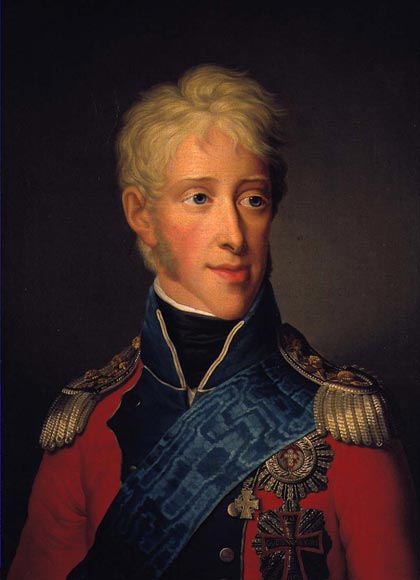<Back to Index>
- Physicist and Chemist Auguste Antoine and Jean Felix Piccard, 1884
- Pianist Arthur Rubinstein, 1887
- King of Denmark Frederick VI, 1768
PAGE SPONSOR

Frederick VI (Christiansborg, 28 January 1768 – Amalienborg, 3 December 1839) reigned as King of Denmark (13 March 1808 – 3 December 1839), and as king of Norway (13 March 1808 – 7 February 1814). His mother, Queen Caroline Mathilde, was a sister of King George III of the United Kingdom.
Frederick's father, Christian VII, had major psychological problems, including suspected schizophrenia, expressed by catatonic periods, that resulted in his standing down from power for most of his reign. On 8 January 1772, the three year old Prince Frederick was made regent. But until 1784 he was under control of his father's stepmother and Queen dowager, Juliana Maria of Brunswick - Wolfenbüttel, who was the real and undisputed ruler during this part of his regency, aided by Ove Høegh - Guldberg. Finally, on 14 April 1784, the crown prince was declared of legal majority. He continued as Regent of Denmark under his father's name until the latter's death in 1808.
During the regency, Frederick instituted widespread liberal reforms with the assistance of Chief Minister Andreas Peter Bernstorff, including the abolition of serfdom in 1788. Crises encountered during his reign include disagreement with the British over neutral shipping. This resulted in two British attacks on Danish shipping in 1801 and 1807. The former attack is known as the Battle of Copenhagen.
His wife was his first cousin Marie Sophie of Hesse - Kassel,
a member of a German family with close marriage links with the Royal
families of both Denmark and Great Britain. They married in Gottorp on 31 July 1790 and had eight children. The youngest of them, Princess Wilhelmine, became the wife of the future Frederick VII of Denmark. However, none of Frederick VI's sons survived infancy and when he died, he was succeeded by his cousin, Christian VIII of Denmark. Frederic was crowned King of Denmark on 13 March 1808. When the throne of Sweden showed
signs of becoming unoccupied in 1809, Frederick was interested in
becoming elected there, too. Frederick actually was the first monarch
of Denmark and Norway to descend from Gustav I of Sweden who
had secured Sweden's independence after a union period with other
Scandinavian countries. (Also Frederick's sister was such a descendant,
both through their mother and her mother. As well as Hereditary Prince Frederick of Denmark, their uncle, who descended through Queen Juliane.) However, Frederick's brother-in-law, the prince Augustus of Augustenborg, got elected, and later the French Marshal Bernadotte. After his defeat in the Napoleonic Wars in 1814 and the loss of Norway, Frederick VI carried through an authoritatarian and reactionary course, giving up the liberal ideas of his years as a prince regent.
Censorship and suppression of all opposition together with bad economic
terms of the country made this period of his reign somewhat gloomy,
though the king himself in general maintained his position of a
"patriarch" and a well meaning autocrat. From the 1830s the economic
depression was eased a bit and from 1834 the king reluctantly accepted
a small democratic innovation in the creation of the Assemblies of the
Estate (purely consultative regional assemblies). Frederick VI was known as a patron of astronomy and in 1832 offered gold medal prizes to anyone who discovered a comet using a telescope. His successors continued this until 1850. The prize was terminated in the aftermath of the First War of Schleswig. After discovery of Haraldskær Woman in
a peat bog in Jutland in the year 1835, Frederick VI ordered a royal
interment in an elaborately carved sarcophagus for the Iron Age mummy,
decreeing it to be the body of Queen Gunhild. Later this identity proved incorrect, but the action suited his political agenda at the time. He was the 894th Knight of the Order of the Golden Fleece in Spain and the 654th Knight of the Order of the Garter in 1822.